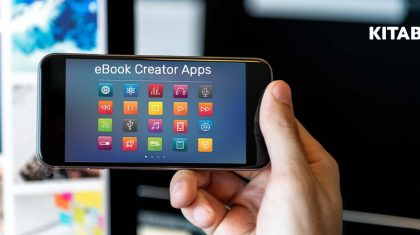
Unlocking Learning: Digital Content for K-12 Education
Educational technology and education are advancing daily and are not limited to schools and higher education institutions. Educational technology is rapidly evolving, extending beyond traditional classrooms to revolutionize learning across industries and age groups.
From schools to corporate training, digital resources are reshaping how people acquire knowledge and skills, offering flexibility and interactivity unparalleled by traditional methods.
For K12 learners, digital textbook platforms like KITABOO provide immersive experiences, fostering collaboration and personalized learning. This platform caters to student’s diverse needs, offering interactive multimedia elements, adaptive learning features, and real-time assessments.
Table of Contents:
I. Understanding Digital Content in Global K12 Education
II. Benefits of Digital Content in Global K12 Education
- Inclusive Learning Environments in K12 Education
- Improved Learning Outcomes
- Personalized Learning Experience
- Collaboration and Communication
- Enhanced Digital, Academic, and Literacy Skills
III. The Role of Technology in Enhancing K-12 Education
IV. How Digital Learning Transforms K-12 Classrooms
V. Types of Digital Content for K-12 Learning
VI. Strategies for Implementing Digital Content in Global K12 Education
- Adopt the Latest K12 Digital Resources and Trends
- Use School Management Software
- Utilize Student Information Systems
- Opt for Digital Learning Platforms
- Use Big Data for Tracking Performance
- Embrace AI for Assessment and Analysis
VII. Future Trends in Digital Content for K-12 Education
VIII. Wrapping Up
IX. FAQs
Understanding Digital Content in Global K12 Education
Digital or online content refers to the plethora of sources and options that offer massive amounts of learning content for K12 educational purposes.
Students can conduct research on the internet, watch educational videos, and utilize digital textbook platforms like KITABOO to access K12 digital resources.
Here are some of its characteristics:
- Digital content also includes designed courses, eTextbooks, workbooks, subject-specific ebooks, audiobooks, and learning materials that can be used anytime and anywhere.
- It incorporates features like mobile learning, active participation, and gamification.
- K12 digital learning courses through learning platforms offer immense interactivity and engagement. This is done using charts, diagrams, elaborate explanations of complex topics, practical solutions, infographics, and case studies.
- It dismantles geographical barriers and rigid schedules.
- Students can avail themselves of learning materials and sessions from any location with internet connectivity.
- It grants K12 learners the flexibility to learn at their own pace and convenience.
- It proves particularly beneficial for students with disabilities or those situated in remote areas where attending traditional classrooms may pose challenges.
Benefits of Digital Content in Global K12 Education
Here are the top benefits of online content in global K-12 education:
1. Inclusive Learning Environments in K12 Education
Digital accessibility ensures that all students, irrespective of their abilities, can actively participate and engage in the learning process.
It encourages an inclusive classroom setting where every student enjoys equitable access to educational materials, resources, and technology. Digital accessibility eradicates barriers and extends equal opportunities to all students, regardless of their physical or cognitive capabilities.
2. Improved Learning Outcomes
By furnishing accessible digital content, K12 education empowers students to access information in diverse formats, such as text, audio, or video, catering to varied learning styles. This adaptability augments comprehension, engagement, and overall learning outcomes, thereby enhancing academic performance.
3. Personalized Learning Experience
Digital content in global K12 education facilitates personalized learning by allowing educators to modify content and deliverables according to their unique needs and preferences.
Students can also alter the way they consume content. They can use eBook libraries and carry a stock of materials with them anywhere. They can adjust reading settings on eBook Reader apps that allow them to read and learn at their convenience.
4. Collaboration and Communication
Digital tools offer a platform for collaboration and communication among stakeholders like students, teachers, and parents.
There are various discussion forums, collaborative workspaces, and video conferencing that eliminate geographical barriers, and empower students to collaborate on projects with peers from around the globe. They can engage in face-to-face interactions with stakeholders for a dynamic exchange of ideas and cultures.
5. Enhanced Digital, Academic, and Literacy Skills
Integrating digital content into K12 education develops digital literacy skills among students. Through educational technology, students gain knowledge about design principles, the practicality of STEM-based subjects, and fair technology utilization.
Interactive features make digital and academic concepts more captivating, and K12 learners can choose their preferred paths and access materials that resonate with them. Online assessments, games, tests, and quizzes help prompt feedback and help students identify areas of improvement.
The Role of Technology in Enhancing K12 Education
The mainstreaming of educational technology in K12 education has transformed students’ interactions with learning materials. Now, through digital learning platforms and educational technology, students have opportunities for personalized resources, adaptive learning tools, and interactive content to meet their learning needs in a way that best suits them.
Easy collaboration, improved comprehension, and flexible learning can enhance the classroom environment. For example, let us consider how the student information management system plays an essential role in tracking progress, managing academic records, and providing educators with the data required to support students’ development.
Recent studies indicate that 79% of students claim that technology and education help them prepare for exams, while 71% agree that they enhance their engagement with study materials.
How Digital Learning Transforms K12 Classrooms
Here are the key changes digital education brings to K12 education:
- Personalized Learning: Lessons are tailored according to every student’s need, pacing, and learning style
- Accessibility: It provides resources for students who have diverse needs, and thus makes learning more accessible
- Collaboration: Real-time collaboration between students can be made possible, promoting teamwork and communication
- Engagement: Interactive content such as videos and gamified lessons are sure to boost engagement levels among students.
- Evaluation: It encompasses instant feedback through quizzes and assessments; this opens up opportunities for ongoing improvement.
Types of Digital Content for K-12 Learning
There are different kinds of online content, for example:
- Interactive eBooks: They contain multimedia such as audio, video, and quizzes. These make reading fun.
- Gamified Learning Platforms: These platforms use game-like mechanics to teach math or science, making them fun and competitive.
- Video Lessons: Pre-recorded lessons or live streaming brings topics to life through visual and auditory stimuli.
- Virtual Labs and Simulations: Let the students experiment and practice without requiring physical resources.
- AI-Powered Educational Technology: Provides personal support and feedback to the student through AI-driven applications.
Integrating AI in Digital Learning Platforms
Artificial intelligence is transforming K12 education by offering adaptive environments aligned with every student’s needs. AI supports digital learning platforms that analyze student data to personalize the learning experience.
These platforms offer additional resources for students, and even the administrative workload of educators is streamlined for more instruction and more student time. Based on a study conducted in 2024, the global AI in education market is expected to reach USD 112.30 billion by 2034 from USD 5.18 billion in 2024, at a CAGR of 36.02%.
Leveraging Big Data for Personalized Learning
Big Data is yet another technological innovation that encourages personalization in K12 schooling. By tracking data related to students’ performance, behavior, and level of engagement in real-time, schools can construct student-specific learning plans.
Analysis from student information management systems enables teachers to identify and address gaps in knowledge, alter the instruction method based on the analysis, and address students’ specific academic shortcomings.
Strategies for Implementing Digital Content in Global K12 Education
Before you start implementing and utilizing digital content through eLearning platforms, understand the goals and objectives for K12 digital learning initiatives.
Here are some key strategies that you can employ:
1. Adopt the Latest K12 Digital Resources and Trends
To encourage a more practical learning environment for K12 learners, the education industry must keep its content updated according to student demands and the latest standards.
The top eLearning trends for K12 Education are
- Flipped Classroom Approach
- Audiobooks
- Digital Content Libraries
- Social Media Platforms
- Simulation Games
- Augmented Reality and Virtual Reality
- Interactive Video-Based Lectures
- Mobile Learning
- Personalized Learning Modules
2. Use School Management Software
Implement school management software to streamline administrative tasks like attendance tracking and resource allocation. Use proper cloud-based solutions like KITABOO to access various eBooks and libraries and to enhance K12 Learning efficiency.
3. Utilize Student Information Systems
Utilize student information systems to centralize and manage student data effectively, help data-informed decision-making, and manage effective distribution of content. Such platforms capture student data and optimize educational technology outcomes.
4. Opt for Digital Learning Platforms
Online learning platforms make it easier to access and deliver digital content to students. Choose platforms that offer features such as interactive multimedia elements, adaptive learning, real-time assessments, and collaborative tools.
Incorporate user-friendly platforms like KITABOO to facilitate online and blended learning experiences. This way, educators can seamlessly integrate online content into their lessons, providing students with engaging and interactive learning opportunities.
5. Use Big Data for Tracking Performance
Utilize the best platforms to analyze datasets and provide insights into student and faculty performance. Successful implementation of these technologies supports better decision-making and enhances educational technology outcomes.
Moreover, educational institutions handle sensitive information, such as student records and personal details, making data security paramount. To safeguard this information, use platforms that employ DRM to implement measures like encryption, two-factor authentication, and regular data backups.
6. Embrace AI for Assessment and Analysis
The adoption of generative AI for assessment and analysis is on the rise, with technology and education proving its efficacy in practical applications. Predictions indicate that AI integrations with automated solutions, including online learning platforms, will continue to advance, enhance productivity, and reshape the educational landscape. Modern digital platforms help in:
- Addressing infrastructure needs, selecting appropriate digital tools, and integrating technology and education into the curriculum.
- They further provide training opportunities and offer support to facilitate successful digital transformation.
- Regularly assess the progress of digital learning initiatives and gain feedback from staff and students.
- Make necessary adjustments to optimize outcomes.
- Promote flexibility to change to ensure that online learning continues to meet the modern and updated needs of the industry and stakeholders effectively.
Future Trends in Digital Content for K-12 Education
K12 learning is becoming rapidly different with the use of technology in education as digital content is increasingly adopted. Here are some of the key trends that will define the future of online content in K12 education:
- AI-Powered Personalized Learning
AI will transform the presentation of digital content, curating lessons according to students’ needs. AI may analyze student progress and suggest specific learning materials and learning pathways, thus making learning more personalized than ever before.
- Virtual and Augmented Reality (VR/AR)
VR and AR in classrooms will offer immersive learning experiences as students are transported to new environments, from exploring historical events to conducting virtual science experiments. These technologies benefit subjects such as geography, history, and biology as students can interact with 3D simulations.
- Big Data for Predictive Analytics
Big data in K12 technology and education is transforming classroom instruction by providing educators with real-time information about student performance and related learning behaviors. Predictive analytics can potentially identify students at risk, identify interventions, and improve general learning environments.
- Interactive Digital Textbooks
Interactive digital textbooks that contain multimedia elements such as videos, quizzes, and animations are replacing traditional textbooks. These textbooks adjust according to the responses of students, making learning through technology and education more dynamic.
- Adaptive Learning Platforms
Adaptive learning platforms are, therefore, constructed to respond to needs as they arise on an individual student basis and in real-time. The challenge level and how content is presented will evolve depending on how students react so that the learner will always be faced with challenges and not be burdened with the lesson.
Wrapping Up
The pervasive influence of digital eLearning platforms and the widespread availability of digital content in global K12 Education signify a transformative shift toward inclusivity in learning.
Such opportunities enhance learning outcomes and ensure equal opportunities for all students in K12 Schools. They also enhance academic and literacy skills, which prepare students for a career-prospective and technology-driven future.
Digital textbook platforms like KITABOO prioritize inclusive learning and content-distribution approaches that present an opportunity to create more engaging learning experiences. With this platform, you can seamlessly integrate interactive multimedia elements, adaptive learning features, and real-time assessments, catering to diverse learning needs and preferences.
Contact us for further details!
FAQs
Online content in K12 education refers to electronic materials that support teaching and learning. These can include interactive books, videos, and simulations, among others, to support various learning styles in different subjects.
Digital learning in education makes the teaching process more interesting, accessible to learners, and self-paced by the learner. It facilitates greater participation by students and even enables real-time feedback, as it makes learning flexible in any required way.
Digital content makes learning interactive, accessible, and adaptive. Its integration allows engagement in class; assessments are graded in real-time to provide feedback simultaneously. It also caters to many varieties of learning resources to improve overall educational results.
Technology supports inclusive learning as it encompasses tools for diverse learners, such as students with disabilities. Digital content is easily adapted for visual, auditory, or cognitive needs, ensuring equal access for all students to educational technology resources.
Schools can effectively utilize digital content by training educators on using technology, adopting blended learning models, utilizing reliable internet connectivity, and finally, utilizing Student Information Management Systems to monitor their students' overall performance.
A Student Information Management System is a software-based platform for schools that could track information about the students, such as grades, attendance, and even behavioral records, for better decision-making and personalizing the process of learning.
Digital content enables teamwork through the use of online shared platforms, group projects, and channels that will facilitate and connect real-time communication. That means the students can effectively work anywhere from any location.
In 2024, the latest developments in digital content for education include AI-driven personalized learning platforms, virtual reality simulations, gamification, and big data analytics to track and enhance student outcomes.
Discover how a mobile-first training platform can help your organization.
KITABOO is a cloud-based platform to create, deliver & track mobile-first interactive training content.



